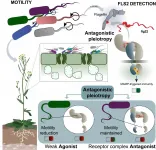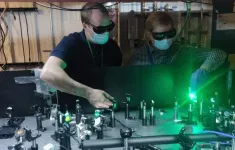Turning wood into plastic
A research team, led by YSE professor Yuan Yao and Liangbing Hu from the University of Maryland, has created a high-quality bioplastic from wood byproducts that they hope can solve one of the world's most pressing environmental issues
2021-03-25
(Press-News.org) Efforts to shift from petrochemical plastics to renewable and biodegradable plastics have proven tricky -- the production process can require toxic chemicals and is expensive, and the mechanical strength and water stability is often insufficient. But researchers have made a breakthrough, using wood byproducts, that shows promise for producing more durable and sustainable bioplastics.
A study published in Nature Sustainability, co-authored by Yuan Yao, assistant professor of industrial ecology and sustainable systems at Yale School of the Environment (YSE), outlines the process of deconstructing the porous matrix of natural wood into a slurry. The researchers say the resulting material shows a high mechanical strength, stability when holding liquids, and UV-light resistance. It can also be recycled or safely biodegraded in the natural environment, and has a lower life-cycle environmental impact when compared with petroleum-based plastics and other biodegradable plastics.
"There are many people who have tried to develop these kinds of polymers in plastic, but the mechanical strands are not good enough to replace the plastics we currently use, which are made mostly from fossil fuels," says Yao. "We've developed a straightforward and simple manufacturing process that generates biomass-based plastics from wood, but also plastic that delivers good mechanical properties as well."
To create the slurry mixture, the researchers used a wood powder -- a processing residue usually discarded as waste in lumber mills -- and deconstructed the loose, porous structure of the powder with a biodegradable and recyclable deep eutectic solvent (DES). The resulting mixture, which features nanoscale entanglement and hydrogen bonding between the regenerated lignin and cellulose micro/nanofibrils, has a high solid content and high viscosity, which can be casted and rolled without breaking.
Yao then led a comprehensive life cycle assessment to test the environmental impacts of the bioplastic against commons plastics. Sheets of the bioplastic were buried in soil, fracturing after two weeks and completely degrading after three months; additionally, researchers say the bioplastic can be broken back down into the slurry by mechanical stirring, which also allows for the DES to be recovered and reused.
"That, to me, is what really makes this plastic good: It can all be recycled or biodegraded," says Yao. "We've minimized all of the materials and the waste going into nature."
The bioplastic has numerous applications, says Liangbing Hu, a professor at the Center for Materials Innovation at the University of Maryland and co-author of the paper. It can be molded into a film that can be used in plastic bags and packaging -- one of the major uses of plastic and causes of waste production. Hu also says that because the bioplastic can be molded into different shapes, it has potential for use in automobile manufacturing, as well.
One area the research team continues to investigate is the potential impact on forests if the manufacturing of this bioplastic is scaled up. While the process currently uses wood byproducts in manufacturing, the researchers say they are keenly aware that large-scale production could require usage of massive amounts of wood, which could have far-reaching implications on forests, land management, ecosystems and climate change, to name a few.
Yao says the research team has already begun working with a forest ecologist to create forest simulation models, linking the growth cycle of forests with the manufacturing process. She also sees an opportunity to collaborate with people who work in forest-related fields at YSE -- an uncommon convenience.
"It's not often an engineer can walk down the hall and talk to a forester," says Yao.
INFORMATION:
ELSE PRESS RELEASES FROM THIS DATE:
2021-03-25
Researchers from the Center for Health, Work & Environment (CHWE) at the Colorado School of Public Health have published a paper in the International Journal of Environmental Research and Public Health studying the effectiveness of applying Total Worker Health (TWH) in an international context. The study, led by a team at CHWE, is the first to examine how a TWH framework operates outside of a western context in Latin America workforces.
"Although recent reviews show that TWH intervention studies have had some global reach, the vast majority have been conducted in Western countries," says lead researcher Diana Jaramillo. "While global organizations, as well as governmental entities in Latin America, acknowledge the importance ...
2021-03-25
Researchers at GMI - Gregor Mendel Institute of Molecular Plant Biology of the Austrian Academy of Sciences, the University of North Carolina at Chapel Hill and The Howard Hughes Medical Institute (HHMI) use two complementary approaches to unveil a co-evolutionary mechanism between bacteria and plants and also explain complex immune response patterns observed in the wild. Together the papers change the way scientists have been thinking about the relationship of a bacterial antigenic component with its plant immune receptor. The two papers are published back to back in the journal Cell Host & Microbe.
Immune responses have developed in virtually all organisms over evolutionary time scales to protect them from foreign ...
2021-03-25
LOS ALAMOS, N.M., March 25, 2021--A new class of quantum dots deliver a stable stream of single, spectrally tunable infrared photons under ambient conditions and at room temperature, unlike other single photon emitters. This breakthrough opens a range of practical applications, including quantum communication, quantum metrology, medical imaging and diagnostics, and clandestine labeling.
"The demonstration of high single-photon purity in the infrared has immediate utility in areas such as quantum key distribution for secure communication," said Victor Klimov, lead author of a paper published ...
2021-03-25
Opioids are the main driver of fatal drug overdoses in the United States, according to the Centers for Disease Control and Prevention, resulting in 46,802 deaths in 2018, usually because the person stops breathing.
Naloxone -- a Food and Drug Administration-approved medication used to reverse overdoses from opioids, such as heroin, morphine and oxycodone -- works by restoring normal respiration to a person whose breathing has slowed or stopped.
"Opioid overdoses cause the largest number of accidental and avoidable deaths," said Peter Davidson, PhD, associate professor in the Department of Medicine at University of California San Diego School of Medicine. "The human toll of drug addiction is devastating. Using naloxone to prevent opiate overdoses can and has saved many lives."
In ...
2021-03-25
A major goal of organic and medicinal chemistry in recent decades has been the rapid synthesis of three-dimensional molecules for the development of new drugs. These drug candidates exhibit a variety of improved properties compared to predominantly flat molecular structures, which are reflected in clinical trials by higher efficacy and success rates. However, they could only be produced at great expense or not at all using previous methods. Chemists led by Prof. Frank Glorius (University of Münster, Germany) and his colleagues Prof. M. Kevin Brown (Indiana University Bloomington) and Prof. Kendall N. Houk (University of California, Los Angeles) have now succeeded in converting several classes of flat ...
2021-03-25
Skoltech scientists and their colleagues have proposed a new human height inheritance model that accounts for the interaction between various factors that influence adult human height. The research was published in the European Journal of Human Genetics.
Human height is a classical quantitative trait that depends on sex, genetics, and the environment.
Scientists from Skoltech, Novosibirsk State University, the Institute of Cytology and Genetics of the Siberian Branch of RAS, and the Institute of Science and Technology in Vienna analyzed the human height distribution ...
2021-03-25
Buried beneath 20 kilometers of ice, the subsurface ocean of Enceladus--one of Saturn's moons--appears to be churning with currents akin to those on Earth.
The theory, derived from the shape of Enceladus's ice shell, challenges the current thinking that the moon's global ocean is homogenous, apart from some vertical mixing driven by the warmth of the moon's core.
Enceladus, a tiny frozen ball about 500 kilometers in diameter (about 1/7th the diameter of Earth's moon), is the sixth largest moon of Saturn. Despite its small size, Enceladus attracted the ...
2021-03-25
About two decades after first devising a new kind of vaccine, Oregon Health & Science University researchers are unlocking why it stops and ultimately clears the monkey form of HIV, called SIV, in about half of nonhuman primates - and why it's a promising candidate to stop HIV in people.
In scientific papers that were simultaneously published today in the journals Science and Science Immunology, creators of the cytomegalovirus, or CMV, vaccine platform describe the unusual biological mechanisms through which it works.
The findings also helped fine-tune VIR-1111, the CMV-based experimental vaccine against HIV that was developed at OHSU and is now being evaluated in a Phase 1 clinical trial. The trial is being conducted by Vir Biotechnology, which ...
2021-03-25
SILVER SPRING, Md. - As concern has grown over COVID-19 variants and their implications for how well COVID-19 vaccines will protect against the virus, researchers have proposed a method to examine instances of SARS-COV-2 infections in people who have received a COVID-19 vaccine.
Genomic sieve analysis of these so-called "breakthrough" SARS-CoV-2 infections in COVID vaccine trials is a critical tool to identify viral mutations associated with vaccine failure and to predict how vaccination impacts the virus' evolution.
Dr. Morgane Rolland, Chief of Viral Genetics ...
2021-03-25
Scientists at Sinai Health say they have discovered a new pathway that controls dangerous overreactions in a body's immune system, including deadly forms of hyper-inflammation.
In new findings out today in the journal Science, researchers at the Lunenfeld-Tanenbaum Research Institute (LTRI) detail how a protein known as WAVE2, a protein expressed in all immune cells, plays a critical role in maintaining immune system balance.
As part of the research, scientists knocked out, or turned off, WAVE2 in a subset of immune cells in mice, which led to severe autoimmunity and inflammation, ...
LAST 30 PRESS RELEASES:
[Press-News.org] Turning wood into plastic
A research team, led by YSE professor Yuan Yao and Liangbing Hu from the University of Maryland, has created a high-quality bioplastic from wood byproducts that they hope can solve one of the world's most pressing environmental issues




